#count alfred d’orsay
Explore tagged Tumblr posts
Text
On Lord Byron and Count Alfred D’Orsay:

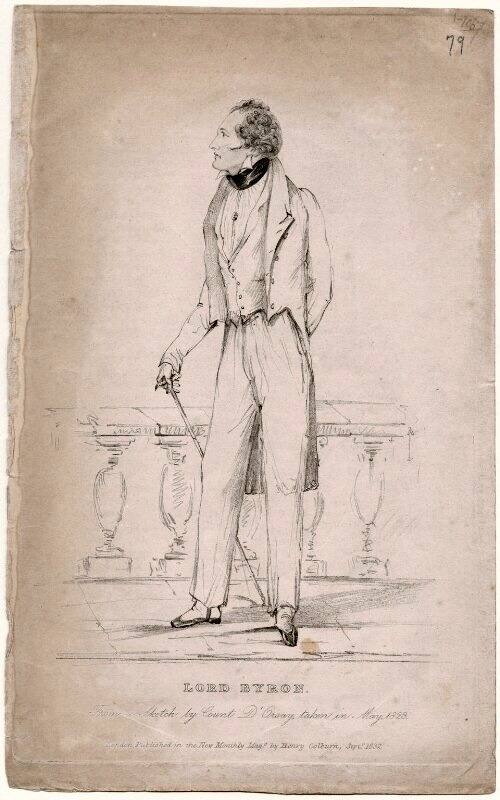



Above are sketches of Lord Byron taken from life by Count Alfred D’Orsay, who Byron described as “a very handsome companion,” “one of the few specimens I have seen of our ideal of a Frenchman,” and who he nicknamed "the young philosopher" and “Cupidon déchaîné” (“raging Cupid”) after a scene from the 1707 play The Beaux' Stratagem by George Farquhar, where a man describes what the ideal portrait of his lover should look like:

Count D’Orsay was famously called the “archangel of dandyism.” He was an artist for the elite, a writer of observation, socialite, dandy, Bonapartist, “man of fashion,” and long-time adulterer with the writer Lady Blessington, whose daughter she had him marry as a front. They divorced, and he eventually died in Paris buried in debts with Lady Blessington. She was a close friend of Lord Byron which is how he got to know D’Orsay better, since D’Orsay lived and travelled with the Blessington family, the husband of which he is also sometimes speculated to have had an affair with. Byron exchanged lavish gifts with the Blessingtons: “I also enclose a ring which I would wish Alfred to keep — it is too large to wear but is formed of Lava — and so far adapted to the fire of his years and character.” D'Orsay was in his early twenties and had already become a popular figure.

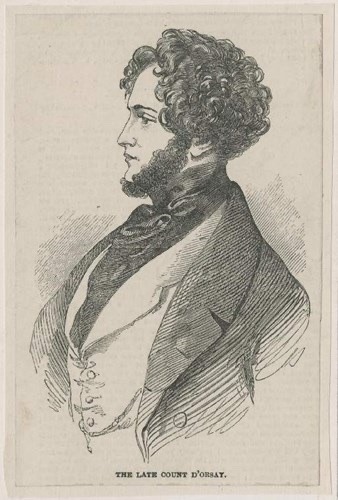

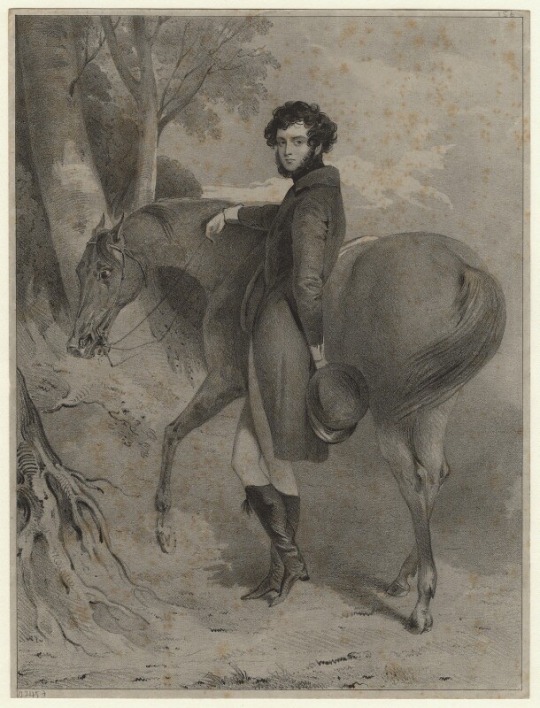
A letter Byron wrote to Count Alfred is as follows:
"April 22. 1823.
My dear Count — (if you will permit me to address you so familiarly), you should be content with writing in your own language, like Grammont, and succeeding in London as nobody has succeeded since the days of Charles the Second and the records of Antonio Hamilton, without deviating into our barbarous language, — which you understand and write, however, much better than it deserves.
"My 'approbation,' as you are pleased to term it, was very sincere, but perhaps not very impartial; for, though I love my country, I do not love my countrymen — at least, such as they now are. And, besides the seduction of talent and wit in your work, I fear that to me there was the attraction of vengeance. I have seen and felt much of what you have described so well. I have known the persons, and the re-unions so described, — (many of them, that is to say,) and the portraits are so like that I cannot but admire the painter no less than his performance.
But I am sorry for you; for if you are so well acquainted with life at your age, what will become of you when the illusion is still more dissipated? But never mind — en avant! — live while you can; and that you may have the full enjoyment of the many advantages of youth, talent, and figure, which you possess, is the wish of an — Englishman, — I suppose, but it is no treason; for my mother was Scotch, and my name and my family are both Norman; and as for myself, I am of no country. As for my 'Works,' which you are pleased to mention, let them go to the Devil, from whence (if you believe many persons) they came."
From the biography D'Orsay; or, The Complete Dandy (Teignmouth, 1911):
"But it is of importance to know that he fell before the charms of the irresistible D'Orsay. Indeed so blinded was he with admiration that he not only discovered the young Frenchman to be 'clever, original, unpretending,' but also stated that 'he affected to be nothing that he was not.' We fancy D'Orsay would not have counted an accusation of modesty as a compliment."
Sources: Lord Byron's letters and journals, Lady Blessington's letters and journals, D'Orsay; or, The Complete Dandy by Teignmouth, 1911.
#fun fact: LB mainly allowed artists to depict his right side bc he said it was his better side#he told d’orsay to add a cap to the one drawing to hide his receding hairline LMAO#diva behavior#his stock looks like a collar#english literature#literature#plays#George Farquhar#lord byron#count alfred d’orsay#portraits#1800s#georgian era#restoration era#art#history#romanticism#lgbt
23 notes
·
View notes
Photo

Centaur. 19th.century. Count Alfred D’Orsay French 1801-1852. engraving. http://hadrian6.tumblr.com
445 notes
·
View notes
Text
THE NEW SUSTAINABLE WOMEN’S SHOES & BOOTS TRENDS
The holiday season is over, and the new year has successfully arrived. It is a great time to look for trendy shoes and boots while making a statement about the environment.
Sustainability is a new luxury.
Vegan and vegetarian leathers, eco-conscious dyes and colors, plant-based materials, and responsible sourcing have become popular and essential. As a result, buyers are not only searching for luxury, comfort, and style, but now they’ve added sustainability to their list of must-have traits for their shoes and boots.
Throughout this article, you will find all the information you need to know about shoes and boots that are fashionable, stylish, comfortable, and help you sustain your health and the health of our planet.
CONTENTS
Types of Shoes
Types of Boots
Material Types
Sustainability
TYPES OF SHOES
There are so many women’s shoes that it can be overwhelming at times but don’t stress because we will break it down for you. Here is a list of each type:

VENICE, ITALY. Expensive ballet flat shoes by luxury footwear brand Christian Louboutin.
1 FLATS
Flats are known mainly for their comfort and versatility. Wear them as everyday or formal footwear. This type of women’s shoes‘ most defining characteristic is their heel-less flat, thin sole. In addition, many kinds of materials, including leather, rubber, plastic, and wood, can be utilized. Furthermore, you slip them on instead of strapping or tying them.
1.1 Ballet Flats
Ballet flats are low-cut shoes that expose the top of the foot and have a closed toe and a low heel. Manufacturing material options include cloth or leather. These women’s shoes originated in the mid-1700s from ballerina slippers worn at that time. They were launched into the mainstream in the early 1900s by Anna Pavlova, a Russian prima ballerina, who ordered them from Italian shoemaker Salvatore Capezio for her entire troop.
In 1941, Claire McCardell, an American sportswear designer, had Capezio create a selection of flats for her collection. As a result, high-end retailers began promoting the women’s shoes in their stores. The style caught fire in the mid-1950s when Brigitte Bardot donned a bright red pair in the 1956 movie “And God Created Women.”

Brigitte Bardot in “And God Created Women”
Audrey Hepburn further catapulted the women’s shoe style into the stratosphere when she wore a custom-designed pair of Ferragamo ballet flats in the 1954 blockbuster movie “Roman Holiday.” Ballet flats combine elegance and comfort in a women’s shoe that provides versatility and ease of wear. These flats can be worn with almost anything but are most popular with Capri pants, skinny jeans, or casual dresses.

Paris, France – Red Patent Brigitte Ballerina Flat by Repetto
1.2 Pointed-Toe Flats
These women’s shoes are a version of ballet flats that expose your foot’s top, but with a pointed toe. In contrast to most pointed-toe shoes that can squeeze the front of your foot and toes together, causing pain and discomfort, pointed-toe flats are designed not to crush your foot.
Their sleek shape lends more style than a ballet flat, so you can wear them with slightly more formal outfits for work like a pantsuit or even skinny jeans with a jacket.

Pointed-Toe Flats
1.3 D’Orsay Flats
Named after French Count Alfred Guillaume Gabriel, D’Orsay flats became popular in the early 1800s. Count D’Orsay, who married into the British aristocracy, became known for wearing stylish shoes with the sides cut out. In addition, he was also known for his stylish hats and coats. These women’s shoes expose the wearer’s top and side of the foot and ankle, so they are sexy and fashionable.
1.4 Slip-Ons
These shoes for women are low cut like the other flats, and like loafers, have no buckles, laces, or straps. They have a more sporty look, are relaxed comfortable, and pair great with a casual outfit.
1.5 Moccasins
Thought to be the oldest shoe in existence, moccasins are shoes that originated before 10,000 BC. Native Americans of the Algonquin tribes used the word to describe the footwear they designed, usually using deerskin or some other soft animal hide to protect their feet.
Each tribe had its variation of the shoes using different soles and seams used to secure the hide at the top of the shoe. Variations of the shoes using other soles and seams European settlers on the east coast of the U.S. began wearing moccasins when supplies from England and quality shoemakers both became scarce.
Moccasins have sides tacked with a vamp and soles without a heel. In addition, materials used include deerskin, soft leather, or suede. They can be worn as slippers while at home or worn with casual clothing for a laid-back style.
1.6 Boat Shoes
While created in 1935 by Paul Sperry to prevent sailors from falling while on the deck of their ships, the defining characteristic of these shoes is the non-marking rubber sole. Sperry observed his dog walking without slipping on the ice or snow one day. Upon closer inspection, Sperry noticed grooves in the paws and then emulated those grooves in the soles of his shoes.
Initially, he used a canvas upper, but Sperry introduced the leather upper just a few years later. Today these shoes are manufactured using leather, canvas, or suede and are a popular casual look worn with jeans or shorts.

D’Orsay Flats

Slip-Ons

Moccasins

Boat Shoes
2 HEELS
High-heels were introduced in the 15th century in Venice by aristocratic women as a status symbol. Caterina de’ Medici continued the trend in the 16th century, and Louis XIV wore them to make up for his modest height. By the Victorian era, women of all classes wore high heels to keep their dresses from dragging on the ground. Today, the medical community understands the health risks, including often irreversible biomechanical effects of high-heeled shoe wear. So, why do so many women still choose to wear uncomfortable and potentially dangerous heels?
Researchers completed biomechanical analyses and found two main reasons: a) High heels give women a more feminine gait. The raised heel shortens a women’s stride and increases the rotation and tilt of the women’s hips. This exaggeration of femininity may make high-heeled women more desirable to men, b) Males prefer women with a particular lumbar curvature, and wearing high heels mimics this optimal lumbar curvature.
Heels have become one of the most iconic types of women’s shoes and fashion trends. Their ability to flatter a woman’s calves, legs, and feet while adding a boost in height makes them the preferred accessory for formal or evening wear. However, high heels can be brutal to walk in and very uncomfortable. Consequently, the longer you have to wear them, the less likely they will be an option.
Heels can range in height from one to eight inches and are available in various uppers. There are dozens of variations of these women’s shoes, but we’ll focus on only several of the most common choices.
2.1 Pumps
Around the 1500s, the flat shoes worn by men and servants were called “pompes.” As fashion trends progressed, the heels became higher, and these “Court” shoes became synonymous with wealth and power. In the mid-1600s, King Louis XIV required those who entered his court to wear pumps with high red heels.
Through the centuries, Court shoes evolved from men’s shoes to embellished heeled shoes worn by women in Europe. Three different heel types emerged during the 1700s, French, English, and Italian heels. French heels were curved, and mid-height, English heels were lower and thicker, and Italian heels were spiked and higher.
Today, pumps are heels known to slip onto the foot and require no buckling or tying. These women’s shoes sport many types of heels but are best known for their use of tall spiked heels. They are a perfect accessory for business and professional attire and the most iconic.


Leopard and black classic pumps by Margaux
2.2 Stilettos
Salvatore Ferragamo invented the steel shank for women’s shoes in 1929. Without that, the construction of these women’s shoes with high heels and arches would be nearly impossible. While taking anatomy classes at USC earlier in the 1920s, Ferragamo learned that the body’s weight rested mainly on the foot’s arch. That was the inspiration he needed to design a ground-breaking solution. The steel shank helped alleviate the intense pain experienced when wearing his high heels without any arch support.
Stilettos are skinny and very high heels (up to 8 inches) named after the stiletto dagger. They allow women to show off their added height while showcasing their legs, ankles, and the top of their feet. These women’s shoes pair with a sexy dress, skirt, or hot pants.

Extravagant sexy pink high heel stilettos.
2.3 Kitten Heels
Kitten heels also date back to Louis XIV of France, who wore both kitten and chunk style heels that were red. The trend became so popular that it spread across Europe to other royalty who wore them at their coronations.
These women’s shoes are similar to stilettos but are much lower and, as a result, more comfortable to wear. For example, you can wear them at the office or events where much standing or walking is required.

Orange Kitten Heel by Prada
2.4 Peep Toes
Peep toes appeared for the first time in the 1940s and described more the upper than the type of heel utilized. So, for example, your toes show at the front of the shoe through a cut-out.
Peep toes feature many heel types and will show off your beautifully manicured feet at least a few of the toes. They are more formal than other open-toe shoes, so they are made to be worn with dresses or skirts.

Peep Toe black Shoe by Louboutin and Light Pink Pexi Peep-Toe d’Orsay Sandal
2.5 Platform Heels
UK designer, Vivienne Westwood, re-inserted these women’s shoes into the fashion industry in the early 1990s. Platform heels feature a platform under the toes so that the inclination of the foot is less than wearing a standard heel. As a result, they are much more comfortable to wear and have become more popular.
You get the added height benefit that a high heel gives you and minor discomfort and stress on the arch of your foot. In addition, platform heels pair with skirts, jeans, and shorts, so you can wear them for just about any occasion.

Steve Madden Beige Platform Heel Shoe
2.6 Block Heels
Block heels are distinguished from other heels by their large, square-shaped heel. They come in different uppers and heights and are known for their comfort and versatility. Launched in 1965 by shoe designer Roger Vivier, they are popular among women today.
This type of women’s shoe is much easier to walk in due to the added stability of the larger heel, and the size of the heel prevents it from getting stuck in sidewalk cracks or grates. In addition, they look great when paired with a business suit or a nice pair of slacks.

Block Heel Shoe Examples
2.7 Mules
Mule’s etymology comes from Ancient Rome. The Latin word “mule” refers to both backless shoes and slippers. From the 16th century to the 19th century, mules were bedroom or boudoir slippers. They did not wear them in public.
Today, mules are heels with no back strap or support for your foot. They are easily slipped on and usually feature an open toe, but they may take some practice to walk in. Mules show off more of your foot, which is sexier than shoes with an entire upper. Pair them with skinny jeans, skirts, or short dresses.

Color Women’s Mules with Heels
2.8 Sling Back
Sling backs feature a strap around the back of the foot over the Achilles tendon. The strap helps with stabilization and keeps the shoe from moving around on your foot. In addition, it lends a bit of style and elegance.
These women’s shoes became popular in the 1940s. For example, pin-up girls used them in photoshoots, exposing their ankles and heels. In fact, large companies used them in their advertising and on magazine covers.

Sling Back
2.9 Ankle Strap
Ankle strap heels feature a small back that envelops the heel and Achilles’ tendon and a strap that goes around the front of the ankle and is either buckled or tied. These women’s shoes provide more foot stability than slingbacks or mules and add elegance and style.

Ankle Strap Shoes
2.10 Birdcage Heels
Salvatore Cangemi invented birdcage heels in 1952. Also known as cage heels, they are known for their heel, which looks like a birdcage constructed of heavy wire. Some designers have placed birds or even a monkey inside the cage heel, showcasing their sense of humor.

Birdcage Shoes by Chanel
2.11 Cone Heels
Launched into the fashion world in the 1980s by French fashion designer Maud Frizon, cone heels are just as their name describes. They are heels shaped like a cone and are largest where the heel attaches to the upper. Their cone shape is very stylish. Consequently, pair them with just about any type of outfit.

Cone Heels
2.12 Flare Heels
Flare heels originated in the 1970s and were named so because they emulate flared jeans. The heels are smaller at the top, attaching to the bottom of the upper, and becoming more expansive as the heel touches the floor. They pair perfectly with bell-bottom jeans and dresses and skirts that flare out at the bottom.
2.13 Lace-up Heels
These women’s shoes are similar to ankle strap heels which have a back on the shoe that helps support and protect the heel and Achilles tendon. The difference is that instead of straps and buckles to help secure the shoe onto the foot, these shoes have laces that wrap around the ankle and then tie just like a classic ballerina slipper.
2.14 Spool Heels
This type of women’s shoes originated in Europe during the 1600s and was aptly named with heels shaped like a cotton spool. These Baroque period heels also became very popular in the mid-1800s.
A variation in the shape of this heel is called the French or Louis heel. It has a larger top where the heel attaches to the upper than the tapered bottom, touching the floor. Their shape makes them much easier and more comfortable to walk in than a slim, pointed heel. Pair them with semi-formal or formal outfits.

Flare, Lace-Up and Spool Heels
3 LOAFERS

Even though loafers are a common choice for men, they are also an increasingly popular option for women’s shoes. Their design originated from Native American moccasins, which slipped on and had no heel. Shoe manufacturers began using the name for that type of footwear in the 1930s.
Loafers usually have a small heel and can be slipped on without being tied or buckled. There are versions made for women with a raised heel and ornamental stitching or tassels, perfect for the office that requires everyday formal wear.
3.1 Penny Loafers
Penny loafers are the most traditional variation of loafers and feature a slot in a leather strap built into the shoe’s upper part. Each slot holds one penny. They are a classic and every boy’s first dress shoe (no laces). It is a lifelong wardrobe staple and the most versatile shoe you will ever slip-on.
Why a penny? In the 1930s, the cost of a call in a phone booth was only two cents. Each shoe holds a penny, so the person wearing them had what they needed to make an emergency call from a phone booth.

Men’s Penny Loafers
3.2 Tassel Loafers
Designed after World War II at the request of Paul Lukas, a famous actor that starred in “Watch on the Rhine,” tassel loafers became very popular. During his travels, he discovered a shoe in Europe that had tassels on the end of the shoelaces and wanted shoemakers in New York and Los Angeles to design something that featured the tassels.

Tassel Loafers By Gucci
4 OXFORDS
Oxfords are manufactured using only one piece of leather and are known for their distinctive look and closed lacing. For example, the eyelet tabs aren’t visible due to their stitching.

Oxford Shoes
This women’s shoe has been around in various forms since the mid-1600s. Named after Oxford University in England, the style became popular among students in the late 1800s. In fact, the students had become tired of wearing boots and opted for a better solution.
4.1 Saddle Shoes
Saddle shoes are a stylish and functional low-heeled Oxford in white leather and have been around since 1906. They get their name from the contrast-colored piece of leather that reinforces the shoe’s instep. The most common color for that piece is black, but brown and blue are also very popular.

Men’s Saddle Shoes by Polo Ralph Lauren
These women’s shoes have a reinforced instep providing added support and stability for rigorous activities. Designed for indoor sports, golfers still use them today. For example, they possess both the support and the wardrobe formality required by golf courses. Saddle shoes enjoyed renewed popularity in the 1950s when dancers wore them while performing popular swing dances like the Jitterbug.
5 PLATFORM
Platform shoes feature thick soles which can range from one to six inches in height. Originally worn by actors, they originated in ancient Greece about 600 BC. The more prominent the character in the play, the higher the platform shoe they wore.
People used platforms to keep clothes from getting soiled or wet in the Middle Ages while walking on the streets. Furthermore, platform shoes became popular with the French elite in the mid-1500s when Catherine de Medici wore them to enhance her tiny frame.
5.1 Platform Heels
A Platform heel is raised significantly higher at the front of the foot and is more comfortable than standard high heels. However, we advise caution because wearing these elevated women’s shoes requires good balance and practice.

6 CLOGS
Clogs dated back to the 13th century in the Netherlands and were traditionally carved entirely out of wood.
They were designed and made to protect the feet from damage while working outdoors or gardening. In fact, clog shoes feature a raised sole and heel, usually the same height.
Over the last few centuries, clogs for women have transformed from a clumsy-looking carved block of wood into a stylish and comfortable option. Wear them for almost any occasion.
6.1 Cork Clogs
One of the most popular clogs styles features a sole manufactured of cork. Cork originates from the bark of the cork oak tree. It grows in southwest Europe and northwest Africa. The harvest occurs every nine years without damaging the tree because the bark regenerates, thus earning an environmental-friendly sustainability reputation.



PAOLA BURGUNDY CLOG JANA ELECTRIC BLUE CLOG PAOLA NUDE CLOG
Humanity has used cork in many forms over the last 5,000 years and possesses remarkable traits. It is fire retardant, buoyant, has a cushioning elasticity, and is impermeable. It is best known for its use as stoppers in wine bottles; it has incredible health benefits as soles for shoes.
The health benefits of cork when used as soles in shoe manufacturing include shock absorption, moisture-wicking, and lighter weight. In addition, the cork’s extra cushioning properties alleviate the pressure on the Achilles tendon and help prevent shin splints when walking on hard surfaces. Its ability to draw sweat away from the feet also prevents the formation of bacteria and foot odor.
7 SANDALS
Sandals originated in ancient Greece around 500 BC and were leather. The type of sandal worn by individuals spoke to their class and position in society.

Women’s Summer Sandals
Sandals are a traditional women’s shoe worn during the summer and usually expose a large part of the foot. They are flat-soled and lightweight due to the amount of material used. Sandals are generally made of plastic, rubber, or leather and are usually a comfortable option for shopping, gym, pool, or casual events.
7.1 Flip Flops
Flip flops are most likely the most popular type of sandal in existence. They are inexpensive and have a minimalist design, usually utilizing a y-shaped strap that slides between the toes to hold it in place. Moreover, flip flops are either plastic or rubber, so they are water-resistant.

Since they allow the feet to breathe and accommodate swelling or expansion due to heat, flip flops are popular for walking on hot summer days, running errands, or coming from a workout. They fit perfectly with shorts, t-shirts, swimwear, and even a casual sundress.
7.2 Gladiator Sandals
Gladiator sandals originated in the 3rd century BC and were used by professional Roman fighters while fighting in arenas in front of large crowds. These shoes had a distinct style characterized by many thin straps attached to the shoe’s sole that ran up and horizontally over the foot.
Today, women’s gladiator sandals are similar to their Roman predecessors and are usually leather. They are a comfortable option to wear with casual outfits like shorts, sundresses, and jeans.

Women’s Gladiator Sandals
7.3 Slides
Slides (aka Sliders) are sandals that sport one large strap that runs from the sole up over the top of the foot near the toes.
They are famous for being used as shower shoes due to their water resistance and protection against athletes’ feet, commonly found on shower floors.

Women’s Slider Shoes
Athletes wear these because they don’t want to wear their sports shoes while traveling to their practice or game sites.
Slides allow them to put their socks on and slide into a sandal, usually made of rubber, which is easy to take off before putting their sports shoes on once they have arrived at the venue.
8 SNEAKERS

Multi-brand Women’s Sneakers
The first sneakers, created by U.S. Rubber in 1892, were called Keds. Using rubber soles and canvas tops, they were nicknamed sneakers due to the person wearing them walking without being heard. Mass production began in 1917, and soon after, Converse created the first sneaker made exclusively for playing basketball.
Sneakers are a lightweight and comfortable choice with a flat rubber sole and don’t usually offer a high level of support like trainers. They are designed to provide more protection for the feet than sandals but use a durable, lightweight, and flexible canvas material.
Sneakers can be worn with shorts and jeans and look cute with summer dresses. They are perfect for casual events and shopping because they are much easier to walk in than most other shoes.
9 BLUCHERS
Bluchers, named after an 18th century Prussian General, Gebhard Leberecht von Blucher, commissioned a boot for his troops with added side pieces positioned over the front of the boot. In fact, due to their popularity, troops throughout Europe wore them.
Today, bluchers are worn extensively and associated with British style and charm.

NATHALIE COCO BLACK BLUCHER
Bluchers are similar to Oxfords in their appearance but feature open lacing instead of closed lacing like Oxfords. For example, the vamp or upper is a single piece of leather integrated into the tongue, and the eyelet tabs are on top.
Leather bluchers are elegant and the most comfortable of this type of shoe. In fact, they provide a classic look with just about any outfit. Wear them with pantsuits, skirts, dresses, and slacks.
10 TRAINERS
Trainers are another name for sports shoes. The most popular trainers are running shoes, but you can also include court shoes like basketball and tennis in this category.


Balenciaga & Louis Vuitton Trainers
10.1 Running Shoes
Running shoes typically have laces that securely bind them according to an athlete’s need. For example, they secure, support, and protect the foot during the intense forces encountered during impact, stopping, starting, and changing direction. In addition, pair these women’s shoes with shorts, jeans, or sweatpants, for an effortless casual look.
Hoka One One Women’s Running Shoe
11 WEDGE
The first wedge shoes, invented by Salvatore Ferragamo in 1936, were wood and cork. Their soles are usually two to four inches thick and offer added height like platform shoes. However, instead of the shoe’s heel being centered under the heel of your foot like they are in most variations of high heels, the wedge-shaped heel continues from the heel forward to the ball of the foot. This structure creates an inclination from the heel to the toe.
Wedges are more comfortable and casual than stilettos, so they are a natural choice for the warmer months. However, they look best when paired with maxi dresses or skirts, flared jeans, or shorts. Wedges also have more stability, and the heel will not get stuck in the cracks of a sidewalk and break off.
11.1 Espadrilles
Espadrilles are wedge sandals with a canvas upper and a sole made of rope. They originated in Spain around 2000 BC and are highly popular in Europe. The Catalan root for espadrille refers to the esparto plant, originally used to create the rope used in the soles. Today, jute and hemp are the most used plants to produce the rope.

Women’s Wedge Espadrilles

Women’s Black Espadrilles

Women’s Silver Flat Espadrilles
These women’s shoes gained worldwide popularity in the 1940s when Rita Hayworth and Lauren Bacall wore them in their blockbuster movies. Once seen onscreen, everyone wanted a pair for themselves.
TYPES OF BOOTS

Luxury footwear brand Christian Louboutin Women Boot Stilettos
Boot variations depend upon the height of the shaft. The shaft is the boot section that rises from the arch upward and measures from your foot’s bottom to the top of the boot. For example, calf boots rise above the ankle and fall below the knee in the calf area of your leg.
Like shoes, there are numerous boots available in the marketplace. In fact, they are most prevalent during Fall and Winter. However, wear them year-round with just about any outfit due to their versatility. Here is a list of each type of boot:
1 ANKLE BOOTS
The shaft of these women’s boots rises to the level of your ankle. Fastening options for boots can be slip-on, have zippers, buckles, or laces.
Their stylish appearance lends a classy look to just about any outfit. For example, boots with a little higher heel dress up, a pair of skinny jeans, tight pants, or a skirt. They are perfect to wear at the office or for a professional event and trendy during Fall.

2 CALF BOOTS
The shaft of this variation of women’s boot rises onto the calf portion of your leg but stays below the knee. Calf boots come in various designs and heel types like ankle boots but typically have a zipper or laces due to the height of the boot on your leg.

Mid Calf Boots
These boots are popular in winter because they keep your legs warm and protect your feet from water and snow. They pair perfectly with a dress or skirt.
3 THIGH HIGH
Thigh-high boots get their name from the shaft of these women’s boots reaching up to the lower or mid-thigh. In addition, they come in different heel types and are most popular in leather and suede.

Thigh High Boots
If you wear fitted jeans, thigh-high boots look fantastic and make a fashion statement. They can be worn any time of the year but are usually too warm for summer.
4 COMBAT
Combat boots are military-inspired casual calf boots. They utilize laces just like military boots and have the same clunky, sturdy design. These women’s boots go great with just jeans and a t-shirt but pair well with a skirt or jean jacket.

Combat Boots
5 COWBOY
Cowboy boots are slip-on calf-high boots. They have a pointed toe, so the boot easily slides into a stirrup and a prominent heel that keeps the boot from sliding forward through the stirrup. In addition, cowboy boots are made of leather to protect feet from the abrasion of stirrups, horses, venomous snakes, and barb wire.

Women’s Cowboy Boots
These women’s boots can be paired with jeans or skirts and are popular when going line dancing or out to a western-themed nightclub.
6 RAIN
This boot was designed merely for the practical purpose of preventing your feet from getting wet. Rain boots are typically rubber, are not insulated, and are waterproof. Their shaft usually rises to the upper calf region of your leg or to just below the knee so water will not splash into the boot.
Women’s rain boots are a must-have if you live in a region that receives a large amount of annual rainfall or snow.

Women’s Rain Boots
MATERIAL TYPES
Shoe and boot manufacturing use three primary materials: 1) animal, 2) plant, and 3) synthetic. See them here below broken down by category:
1 ANIMAL
1.1 Cowhide/Horsehide Leather
Cattle and horse leather is the most widely used material for shoes and boots due to its durability and the many variations it offers. Here is a list of the most commonly used leathers in shoe and boot making:

Horsehide Leather Shoes
1.2 Shell Cordovan
This type of leather is the rarest and most sought-after of all leathers. It comes from the hindquarters of a horse. Naturally water and stretch-resistant due to high pore density, it is the hardest to tan and work. For instance, tanning can take up to six months, and very few tanneries can handle it. Shoes made of Cordovan are expensive but will last for 50 years or more if cared for properly.

Shell Cordovan Leather
1.3 Roughout
This leather utilizes the rough flesh side of the hide as the outside of the shoe. It is durable enough for heavy use, breathes better than rough-in leather, and has a soft nappy feel that doesn’t require shining.

Roughout Leather shoes
1.4 Suede
Like roughout, suede utilizes the rough flesh side of the hide. The main difference is that the hide is sanded and buffed down to a texture that makes it thin and pliable. That’s why it is so popular for making gloves and other delicate clothing.

Women’s Suede Loafer and Gloves
1.5 Calfskin
The source of this leather is young calves and has a fine grain that is durable and free of imperfections. Calfskin is thin and pliable leather that lasts for years if cared for properly and responds very well to a high polish.
1.6 Vegetable Tanned
This leather is tanned using tree bark and vegetable matter. The result is a stiff leather that, over time, softens, darkens, and has a fantastic sheen to it. However, water will cause this leather to shrink and crack when it dries, so follow proper care for it to last.
1.7 Pull-Up
This type of leather is aniline or chrome-dyed in a drum and then finished by heavily oiling and waxing it. The result is very soft leather which changes color when stretched or pulled when used in manufacturing. In addition, it is a very low-maintenance product that readily absorbs scrapes and scuffs.
1.8 Reptile
For many years, artisans have used reptile skins as an alternative to horse and cattle hides, especially in areas where large reptiles are indigenous. Unfortunately, they are more expensive here in the U.S. due to their difficulty to acquire, and some of the species are also on the endangered list, so they are not a responsible option.
2 PLANT
2.1 Cork
As outlined in the Cork Clogs section of this article, cork’s properties include impermeability, buoyancy, elasticity, fire retardation, and extremely lightweight.

Cork Material and Nathalie Coco black Blucher with cork sole
2.2 Wood
Wood, other than cork, is still being used extensively to make heels for women’s shoes and boots. It is also a preferred choice for making heels for cowboy boots. Of course, don’t forget about Dutch wooden clogs manufactured exclusively of wood.
2.3 Hemp
The use of hemp thread in shoemaking dates back to the 14th century. Hemp has a 23% higher resistance to tearing than other threads, and it is waterproof, so it makes an excellent choice for manufacturing.

Hemp Plant and Fabrics
2.4 Jute
One of the most affordable fibers available on the market today, jute is used to produce rope and thread. It is most widely used to make burlap bags or gunny cloth, but it is also prevalent in manufacturing espadrilles in Bangladesh, the world’s largest producer of jute.

Jute Fabric
2.5 Cotton
Many garments and shoes use cotton due to its versatility and breathability. In addition, it is also mixed with polyvinyl chloride (PVC) to manufacture canvas, one of the most popular materials used to manufacture sneakers.

Cotton Field and Cotton Fabrics
2.6 Linen
Linen is derived from the flax plant and is widely used as a very popular fabric and for thread in the manufacturing of shoes and boots due to its strength and durability. This fabric is also mixed with PVC to manufacture canvas.

Soft Color Linen Fabric Samples
2.7 Silk
Silk is used in several ways in shoemaking, from the cloth used in the upper to the thread used for stitching due to its natural elasticity. In addition, it also lends a beautifully natural sheen when used as the fabric for a women’s upper.


Nicole Goymann and Christoph John create shoes from silkworm cocoons and Women’s Red Silk Shoes
3 SYNTHETIC
3.1 Rubber
Natural rubber, comprised of latex, a milky substance found in rubber-producing plants, is primarily found in South American rainforests, India, and Southeast Asia. Unfortunately, today’s manufacturing of boots and shoes for both soles and uppers primarily uses synthetic rubber.
3.2 Plastic
The plastic used in shoe and boot-making comes in many forms. Some of the variations include polyvinyl chloride (PVC); polyurethane (PU), which is rigid; ethylene-vinyl acetate (EVA), which is tough and flexible; and thermoplastic polyurethane (TPU), which is flexible and has elasticity.
3.3 Polyester
Polyethylene terephthalate is the chemical name for polyester. The garment and shoe industry widely uses this fiber. In fact, you can find it both inside and outside of shoes and boots due to its durability, fire retardant, and lightweight properties.
3.4 Nylon
Polyamide is the chemical name for nylon. Shoe and boot manufacturing commonly use both nylon and polyester in manufacturing. Nylon is more expensive to produce. However, it is more durable and weather-resistant than polyester but has one-fifth of the worldwide production.

Nylon Sport Shoe
3.5 Steel
The manufacture of shoes and boots commonly uses steel shanks, plates, and toes. The shanks and plates reinforce the shape of the shoe or boot and help maintain the shape. In addition, steel toes in safety shoes and boots help protect against foot injury from heavy items crushing your toes.
SUSTAINABILITY
Several factors make sustainability in shoe and boot manufacturing significantly more critical. First, the sheer volume of shoes and boots produced is estimated to contribute approximately 700 million metric tons of carbon dioxide equivalent emissions to our atmosphere each year.
Besides the emissions, the use of toxic chemicals in tanning and manufacturing, plus the synthetic products produced using petroleum products, presents a massive threat to our environmental well-being.
Eco-friendly alternatives must be used when available instead of using products or processes that harm our environment. Here are some of the materials used and processes that are eco-friendly alternatives:
1 LEATHER TANNING
The process of converting animal hides to leather is called tanning. There are various ways in which tanning occurs, which plays a significant role in the characteristics of the finished product. In addition, they also impact the environment differently.
Chromium tanning was developed in 1858 to replace more expensive and time-consuming vegetable tanning. This less natural process involves soaking the hides in acidic salts using acids, chromium sulfates, and other chemicals. Unfortunately, these chemicals harm our environment, and the industry is under heavy scrutiny as more environmental regulations emerge.
Vegetable tanning is an environmentally friendly method that has been used for thousands of years and uses a solution comprised of tree bark like oak or chestnut. Unfortunately, only about 10% of the leather worldwide is tanned using this method due to its high cost, skillful, and lengthy process. Still, this leather can be considered biodegradable and eco-friendly.

Leather Tanning
2 VEGETABLE LEATHER
Vegetable leathers are produced solely from plants. Examples include desert cactus, grapes, mushrooms, pineapples, and mangos. In fact, vegan or vegetable leathers’ processing doesn’t use toxic chemicals or harmful substances. In addition, they are hand-processed, and these leathers also do not create sourcing issues.
The cactus is naturally abundant, and the grape source is grape waste leftover after winemaking. The mushrooms used in the vegan leather are harmful to trees, so their removal helps the forest, and the mango leather utilizes only discarded mangos.
Some plant or fruit “leathers” are starting to gain traction. One of them is obtained from the leaves of pineapples grown in the Philippines and is called Piñatex. Its production is much more sustainable than traditional leather and is completely animal-free. Piñatex requires less water and no harmful chemicals that are ecologically toxic to wildlife. The leftover leaf waste is recycled and used for fertilizer or biomass.

Piñatex Extraction and Final Product Sample
3 WOOL
Wool is considered one of the most eco-friendly materials used in manufacturing women’s shoes and boots. It uses approximately 70% less water than cotton and about 20% less energy than polyester to produce the same fabric.
Since fleece is sheared from sheep annually and then regrows, it has a very low environmental impact and is the most sustainable of animal materials used in manufacturing.
4 CORK
Cork is one of the most environmentally responsible materials used to make women’s shoes and women’s boots. For example, they periodically strip the bark, which naturally regenerates. As a result, the trees continue to live and thrive.
In addition, forests of cork prevent the degradation of the land they are on and provide a sanctuary to many endangered species.
Cork trees absorb a large amount of carbon dioxide, over 40,000 pounds, during their lifetime, which keeps the gas out of the atmosphere. The trees live over 200 years, so a lot of carbon dioxide is being kept out of the atmosphere.
Cork and its by-products are also biodegradable, so when you add that to its health benefits when used in shoes and boots, you have a huge win-win.
5 HEMP
Manufacturing has used this natural fiber in rope, paper, fuel, and cloth for thousands of years. But unfortunately, political pressure from competing materials like cotton and plastic outlawed it.
Hemp grows easily, requires little water, and needs no pesticides. It returns nutrients to the soil and absorbs carbon dioxide. The carbon dioxide is only returned to the atmosphere if the plant is burned or composted. Consequently, during manufacturing, the gas is retained.
Almost everything made with cotton, corn, or soy, can be made sustainably with hemp. It is biodegradable, takes up relatively little room, and produces more pulp per acre than trees.
6 JUTE
Europeans discovered Jute as a substitute for flax in the late 1800s. Like hemp, it grows easily without pesticides, enhances soil fertility, absorbs carbon dioxide, and releases oxygen faster than trees.
In addition, it is also completely biodegradable, recyclable, and uses only natural rainwater to grow. Jute is another sustainable option like hemp that fights the adverse effects of cotton on our planet.
WRAPPING UP
Sustainability is an initiative to preserve the resources and our lives on earth. The three main principles of sustainability are economy, society, and the environment. Dozens of materials are called sustainable, including those that continue to harm our community and environment.
There are some criteria to consider when thinking about sustainability. Does the material degrade soil, is it derived from petroleum products or uses too much water relative to what it produces? If the answer is yes to any of the questions, then those materials do not positively impact earth’s resources or our lives. We cannot live without water, we cannot grow without fertile soil, and we cannot continue to rely upon fossil fuels. Utilizing eco-friendly alternatives preserves our planet and resources and improves our way of life.
Today, we are experiencing a considerable change in consumer behavior as millennials and generation Z reach the market. Most baby boomers inherently consider luxury brands exclusive due to their high price, exceptional quality, and scarcity. Many luxury brands mass-produce, generating huge excess of products in secondary markets like outlets and consequently are not sustainable. These long-established brands do not comply with the new definition of luxury demanded by new generations.
The meaning of luxury is shifting from being a synonym of “economic status” to incorporating the principles of purpose-driven quality products with cultural credibility and values. In other words, social harmony comes through sustainability/eco-friendly products, processes, and companies.
Sustainability is the new luxury! At eVogued you can explore some of these new brands making a difference.
If you have any comments regarding this article, please email us at [email protected].
0 notes
Text
Skipping along the Surface: Exaggeration in the Antebellum Era

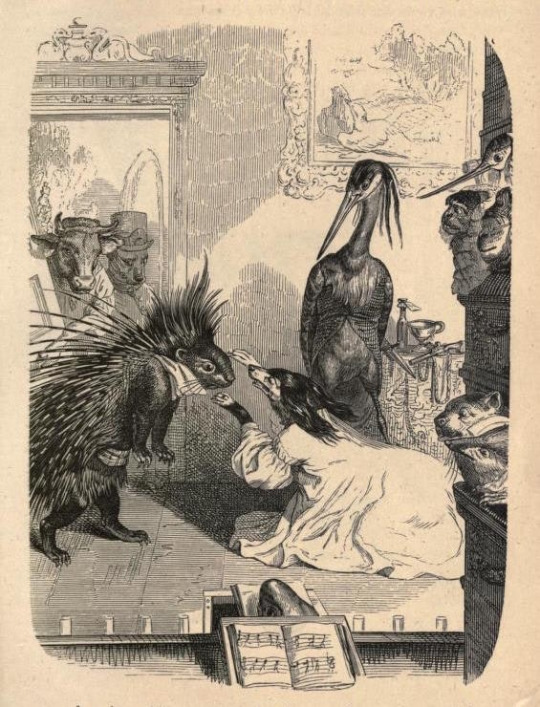
Illustrations from a collection of animal fables, The Public and Private lives of Animals from 1877. Source.
In the early half of the 19th century, the cities were where you wanted to be. An unexpected number of young people were suddenly packing their humble, rural lives and going to the city in hopes of wealth, social life, and to join the tail end of the industrial revolution.
From the moment people set foot in these utopias of stone and iron, the culture around them shifted. These people were no longer in their small towns where everybody knew everybody else (think Huckleberry Finn) instead they were in large cities, with streets full of bustling strangers (who you could never know every single of as more arrived daily). This caused a massive cultural shift in how people interacted with each other (not unlike our technological age), where people feared each other, the unknown, the stranger.
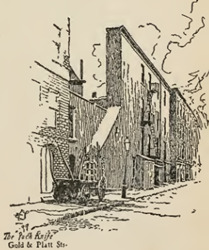
An illustration of a New York Street from the book “Nooks and Crannys of Old New York” (1899). Source
Granted, a fear of strangers has always been present, however there is a stark difference between a single carpetbagger (a lovely word I know) entering your small farming town and an entire street being filled with faces you don’t know. This fear of being unable to discern who can be trusted and who cannot from face alone, caused people to turn to Advice manuals, psuedosciences, and become interested in the externality of the human form with daguerreotype (a form of early photography) galleries, the “art” of Minstrelsy, and what the surface of the form tells. This use of Exaggeration of the human form in the 19th century, from Literature to the pseudoscience of Physiognomy to Minstrelsy, served as the surface of underlining societal fears and beliefs.
The term “Exaggeration” typically simply means, as defined by Merriam – Webster “an act or instance of exaggerating something, overstatement of the truth.” However, I will be asking you to, well, exaggerate the meaning a bit, to include any act twists the truth, draw excessive notice to certain aspects to something, or overall, to make a situation seem comedically unrealistic.
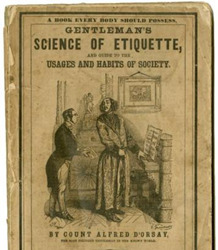
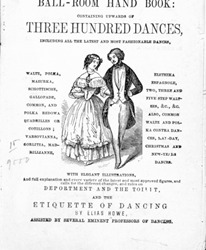
Count Alfred D’Orsay’s 1843 Help Manual on Proper Etiquette, Howe’s 1856 Complete Ball-room Hand Book. Source / Source
This mass migration of the youth to urban areas caused moralists to worry over how these young middle-class people separated from the “surveillance” of their families, towns, and churches would learn how to “properly” live life. Thus, this issue was solved by dozens of teachers, clergymen, and writers in the 1830s who published numerous manuals for living life, in an endless number of topics, like the ones pictured above. These manuals instructed young readers how to have proper manners, morals, appearance, good habits, along with more specific topics like proper dress, ball room dance, what to eat, when and whom to marry, among all other things (Haltunnen 1).
While some were simple etiquette books other manuals exaggerated the dangers of the city, likely only furthering this fear of strangers. While new arrivals were likely easy targets for what these authors describe as “Confidence Men” who preyed on trust, the descriptions of them and their influence was often fantastical. One manual stated, “The moment the inexperienced youth sets his foot on the sidewalk of the city, he is marked and watched by eyes that he never dreamed of” later on in the same passage, “There is she…who now makes war upon virtue and exults in being a successful recruiting-officer of hell.” (2)
These manuals would use words and phrases like “Seducer” and “Force of Evil” to describe the criminals in the cities, linking them to the devil and hell (as Christianity still held a firm grasp on people). Some even claiming the mere presence of these young people in the city can “corrupt them”:
“Feel as they may, contact with evil it is impossible to avoid. If they walk the streets of the city, or tread the floors of the hall, it is to see the sights, and hear sounds, and be subjected to influences, all of which, gradually and imperceptibly, but surely and permanently, are drawing the lines of deformity on their hearts” (5).
They would twist and exaggerate these conmen into masterful archetypal villains, cloaked in the shadows of the large city buildings. In the antebellum advice literature, the dramatic plot became an “inexperienced young man had just set foot in the city when he is approached by a confidence man seeking to dupe and destroy him” (3). This exaggeration of these conmen simply stood in because of people’s fears about strangers in this era (and their influence), along with the fears people had about being duped and deceptions.
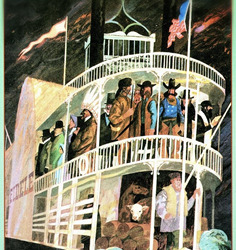
The Norton Critical Edition Cover for The Confidence-Man. Source
Herman Melville, famously known for Moby Dick, published a satirical book in 1857 about “Confidence Men” simply titled The Confidence-Man, commenting on people’s fears of these conmen and the general fear of “the other” people held. In this book, nearly every character is questionable regarding their motives, personality, and “truth” as it were, with very little description regarding them beyond appearance. Some characters only characteristic is their appearance, like “the man in the gray suit” who is a supposed charity man, making light of how people constantly questioned the people around them on surface level characteristics. The man in the grey suit makes a plea of charity, of confidence, to a rich man after explaining his dream of a “world-wide” charity fueled by the taxation of the entire globe:
"Eight hundred millions! More than that sum is yearly expended by mankind, not only in vanities, but miseries. Consider that bloody spendthrift, War. And are mankind so stupid, so wicked, that, upon the demonstration of these things they will not, amending their ways, devote their superfluities to blessing the world instead of cursing it? Eight hundred millions! They have not to make it, it is theirs already; they have but to direct it from ill to good.” (The Confidence Man, pg. 61)
The expanse and exaggeration of this scheme was obviously a prodding to the audience, as the man repeats the phrase “Eight Hundred Millions” to draw the listener back in time and time again as they get lost in his words. While this man is purposely left grey, he uses the language help manuals specified to “Confidence Man” later in the book egging a woman on by preying on her religion and morals. “"Entire stranger! …Ah, who would be a stranger? In vain, I wander; no one will have confidence in me… No one can befriend me, who has not confidence” He says, stretching a hand out to the woman in true or mock desperation, exaggerating his words so it seems he has no assistance in the world (despite the fact two other people gave money to him earlier in the book) (68). The book allows a fog to be cast over everybody, the conmen might be a singular conman in costumes, multiple conmen, or not conmen at all, it is up for the reader to decide after all.

Leonine specimens: Illustration in Giambattista della Porta’s De humana physiognomia (Naples, 1602). Source
This fear of strangers pushed people to figure out methods of determining who is “malicious” and “conniving” in the streets. What better place to turn than a pseudoscience entirely focused on outer appearance? Physiognomy is a pseudoscience about determining people’s inner characteristics by their outer appearance. It focuses on how people’s heads, features, and sometimes limbs are shaped, sized, and compared with themselves and each other. It is readily apparent why people in the 19th century readily enveloped this, choosing to exaggerate people’s appearance for the sake of satisfaction.
Physiognomy have roots dating back to 500 BC, where “Aristotle wrote that large-headed people were mean, those with small faces were steadfast, broad faces reflected stupidity, and round faces signaled courage”. In the 1600s, the first book regarding Physiognomy was published by Giambattista della Porta, believed to be the “Father” of the psuedoscience. The above illustration is from that book, comparing humans to animals (that one being a rather odd-looking lion), implying shared personalities. He guessed that humans have a “pure essence”, suggesting “that one could deduce an individual’s character from empirical observation of his physical features” (Waldorf).
Various books were published regarding Physiognomy in the 19th century, including Comparative Physiognomy: or, Resemblances Between Men and Animals in 1852 and Portraits of Patients from Surrey County Asylum in 1855. We can see the fascination of Physiognomy continue into the 1900s with books such as Vaught's Practical Character Reader from 1902, and The Physiognomy of Hands from 1917.
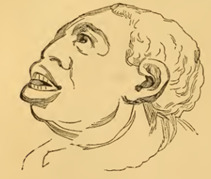

An illustration from Comparative Physiognomy, comparing “Negreos” to the profile of a fish, pg. 171. Source.
Comparative Physiognomy: or, Resemblances Between Men and Animals thus calls back to the first book of Physiognomy, comparing the human form to that of animals and implying shared traits with an emphasis on nationality. From simply reading the chapter list it becomes obvious there is some racial bias in play (Which comes all too easily to Physiognomy). Germans, Englishmen, and Prussians are compared to animals representing strength and cunning like lions, bulls, and cats while “Negroes”, Jews, and “Chinamen” are compared to prey and service animals like fishes, goats, and hogs. The book states, “Are not those half-closed, drowsy eyes, as seen in the portrait on the following page, a striking element of Chinese beauty?” and “The best point in the character of a hog is not a ravenous disposition, but simply a taste for anything and everything—an un-bounded appetite, perfect digestion, and great tendency to grow fat” (Redfield, 167-168).
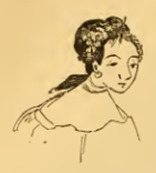

An illustration from Comparative Physiognomy comparing a portrait of a woman to that of a hog, pg. 167. Source
In the chapter that compares Africans to the fishes along their coast, the author states an interesting argument:
Catching negroes is akin to fishing, and the caught are stowed away on board vessels like cod-fish and whale oil; and were it not that they resemble fishes, and that there is a feeling of this, and a dim perception of it, the business would be perfectly infernal. There is always something to relieve men from the charge of being devils incarnate, and to place them in a position in which their reformation is not to be despaired of (81).
James W. Redfield, M.D. (the author of this strange fiction) implies, moreover states, that Physiognomy, the exaggerated dehumanization, enables them to conduct the act of slavery without being condemned in the eyes of god. By dehumanizing the people they are enslaving, comparing them to mere fish on a pole, it enables them to characterize the other. By exaggerating the African form, they enable themselves to follow the beliefs they hold, primarily the act of slavery.
It is curious then that Physiognomy manages to survive to our present day, from the stereotype of the “jewish” nose and exaggeration of African Americans lips, to my mother saying my hands are “piano players hands” to people being described as “mousey” to the term “stuck-up” which comes from Physiognomy thinking.
Various works of the time touched on the topic of Physiognomy either by using the pseudo-science, either seriously or satirically, reversing it as means of discussion, or using it as a means to explore identity. We return to our friend Herman Melville, as he forces the reader to use Physiognomy to decern people, primarily a character called “Black Guinea”. “Black Guinea” is described as “cut down to the stature of a Newfoundland dog; his knotted black fleece and good-natured, honest black face rubbing against the upper part of people's thighs” he later is continually being described as having a “Newfoundland-dog face”. This use by Melville is both a racial and Physiognomy comment, as “Black Guinea” is first treated as if he literally were a dog and later he is considered a conmen, a white man in black makeup (Melville, 13-25).
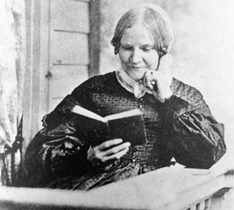
Lydia Maria Child in her older years. Source.
Lydia Maria Child, known for her skills at letter-writing and endeavors for racial justice, fights this pseudoscience by stating the “incongruities” plain in life. Child writes to an unknown, probably nonexistent, recipient about a Scotsman she met:
“A regular Sawney, with tartan plaid and bag-pipe. And where do you guess he most frequently plies his poetic trade? Why, in the slaughter house!...There, if you are curious to witness congruities, you may almost any day see grunting pigs or bleating lambs, with throats cut to the tune of Highland Mary, or Bonny Doon, or Lochaber No More.”
Alongside this, she talks about a sea captain, “Few have interested me more strongly than an old sea captain, who needed only sir Walter’s education…his familiarity with legendary lore, to make him, too, a poet and romancer” (Child, 58). By revealing these incongruities in life, she breaks this simplicity Physiognomy attempts to create, by showing a Scotsman playing beautifully in a place of slaughter, and a sea captain as a poet, a romancer of the masses (a slight jab at “Confidence Men” as well).
Walt Whitman, a poet famously attributed as creating the modern poem, also comments on Physiognomy. In his poem Faces he has lines “Do you suppose I could be content with all if I thought them their own finalé (truth)?” and “This face is a dog’s snout sniffling for garbage. Snakes nest in that mouth, I fear the sibilant threat” And later in, a whole stanza criticizing judging people from the surface:
“I saw the face of the most smear’d and slobbering idiot they had at the asylum,
And I knew for my consolation what they knew not,
I knew of the agents that emptied and broke my brother,
The same wait to clear the rubbish from the fallen tenement,
And I shall look again in a score or two of ages,
And I shall meet the real landlord perfect and unharm’d,
Every inch as good as myself” (The Portable Walt Whitman, 103-105).
Whitman argues that the exaggeration and focus on the human outer form, does not truly state the complexities a human has reducing them to, as he says, a “smear’d and slobbering idiot”. He says you cannot be content if you simply took people at face value, quite literally in this context.
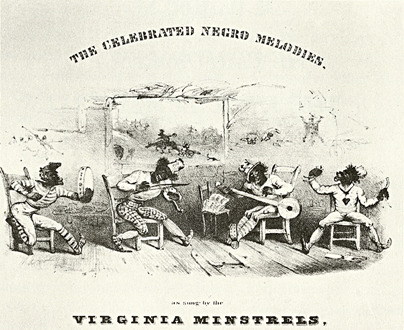
An advertisement for the Virginia Minstrels, a pioneer minstrel show company from 1843. Source.
Finally, exaggeration of the human form in this era is blatantly seen in the tradition of Minstrel shows, otherwise called Minstrelsy. Minstrelsy in the basic sense was white men in blackface, performing the enslaved African Americans dances and songs in an exaggerated caricature. Popular performers of this style were Jim Crow and Tom Rice (jokes on African Americans skin color and occupations). Minstrel shows were popular from the early 19th century, reaching its high point in the years 1850 to 1870. The advertisement above is from one of the most popular and pioneer minstrel groups, the Virginia Minstrels (“Minstrel Show”). This tradition typically had the performers exaggerating their lips and nose, performing a form of theatrical physiognomy.
Again, we return to our friend “Black Guinea” from Melville’s Novel, The Confidence-Man. A part of “Black Guinea’s” implied con is that he is accused of being a white man in black face. “He's some white operator, betwisted and painted up for a decoy. He and his friends are all humbugs” states a man with a wooden leg (Melville, 18). Prior to this, “Black Guinea” is acting extremely exaggerated as these minstrels would be, stating he lives “On der floor of der good baker's oven, sar” then reveals that the baker is the sun, and crawling around like a dog as stated previously. Additionally, he performs a popular minstrel act that readers in the era would know,
“Still shuffling among the crowd, now and then he would pause, throwing back his head and, opening his mouth like an elephant for tossed apples at a menagerie; when, making a space before him, people would have a bout at a strange sort of pitch-penny game, the cripple's mouth being at once target and purse, and he hailing each expertly-caught copper with a cracked bravura from his tambourine” (15)
This exaggeration is used to further cloud what “Black Guinea” really is, is he a crippled black man exaggerating his identity for the sake of the white crowd, or is he a white man in black face performing the illusion of blackness in exaggeration? The book never tells for sure.
Exaggeration in art has, is, and will always be a part of the process. As humans focus on certain aspects, those aspects get enlarged, spotlighted, exaggerated to the point their impossible to ignore. These exaggerations can reveal concerns and beliefs of that society, from the Antebellum help manuals fears of young getting conned, to Melville’s pessimistic satire on way people interacted, to cartoons depicting grown men as cowering children, to comparing humans to fish, to the overtly racist acts of Minstrel shows. These over-the-top, fantastical views of the world reveal to us, in the present, the society’s deepest beliefs and fears of the new age.
It is peculiar then how some of the Antebellum era manages to reflect our own, from the polarized political state, to the discussions of race as unanswered, silenced minorities seek a voice, to the new era of interaction we have over the metaphorical city of the internet. I may be making yet another exaggeration to add on top of the ones I have already shown. What can I say but, it is just another skipping stone along the surface of our culture.
Works Cited
Child, Lydia Maria. “Letters from New-York”. 1841. Pg. 58.
Halttunen, Karen. “Confidence Men and Painted Women : A Study of Middle Class Culture in America, 1830-1870.” 1982, pg. 1-5.
Melville, Herman. “The Confidence-Man: His Masquerade.” 1857. Pgs. 13-25, 61, 68.
“Minstrel Show”. Encyclopædia Britannica, The Editors of Encyclopaedia Britannica, September 2nd, 2020. https://www.britannica.com/art/minstrel-show
Redfield, James W. M.D., “Comparative Physiognomy or Resemblances between Men and Animals.” 1852, pgs. 81, 167-168.
Waldorf, Sarah. “Physiognomy, The Beautiful Psuedoscience.” The Iris, October 8th, 2012. https://blogs.getty.edu/iris/physiognomy-the-beautiful-pseudoscience/
Whitman, Walt. “The Portable Walt Whitman.” Edited by Michael Warner, December 30th, 2003. Pgs. 103-105.
0 notes
Text
RT @Wordsworthians: Today's picture: Byron in Genoa in 1823, by Count Alfred D’Orsay #RomanticsPics http://bit.ly/2iRrwm8
Today's picture: Byron in Genoa in 1823, by Count Alfred D’Orsay #RomanticsPics http://pic.twitter.com/ruV6P7CfsD
— The Romanticism blog (@Wordsworthians) September 2, 2017
from Twitter https://twitter.com/bjohnson September 02, 2017 at 09:11AM via IFTTT
0 notes